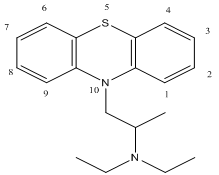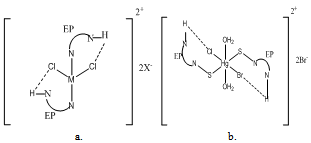-
Paper Information
- Next Paper
- Paper Submission
-
Journal Information
- About This Journal
- Editorial Board
- Current Issue
- Archive
- Author Guidelines
- Contact Us
American Journal of Chemistry
p-ISSN: 2165-8749 e-ISSN: 2165-8781
2012; 2(6): 294-298
doi: 10.5923/j.chemistry.20120206.01
Transition Metal Complexes of Ethopropazine: Synthesis and Characterization
V. Debbeti1, T. J. Ahmad1, S. Ananda2, N. M. Made Gowda1
1Department of Chemistry, Western Illinois University, One University Circle, Macomb, 61455, USA
2Department of Studies in Chemistry, University of Mysore, Manasagangothri, Mysore, 570 006, India
Correspondence to: N. M. Made Gowda, Department of Chemistry, Western Illinois University, One University Circle, Macomb, 61455, USA.
| Email: |  |
Copyright © 2012 Scientific & Academic Publishing. All Rights Reserved.
Ethopropazine (EP) or profenamine is a phenothiazine derivative, N10-(2-diethylaminopropyl)phenothiazine (Figure.1), used as an antiparkinsonian drug that has anticholinergic, antihistamine, and antiadrenergic actions. Transition metal complexes of ZnBr2, CdBr2, CdI2, and HgBr2 have been synthesized using EP as the main ligand and purified by recrystallization in MeOH. These products have been characterized based on their elemental analysis, molar conductance, magnetic susceptibility, IR and 1H-NMR data. The molecular formulations of the new mononuclear complexes have been found to be[Zn(C19H24N2S.HCl)2]Br2,[Cd(C19H24N2S.HCl)2]Br2,[Cd(C19H24N2S.HCl)2]I2 and[Hg(C19H24N2S.HCl) (C19H24N2S.HBr) (OH2)] Br2, where the ligand, EP = C19H24N2S. All the complexes show an ionic ratio of 1:2 in acetonitrile solutions. Molecular structures have been proposed. The four-coordinate complex cations of[Zn(C19H24N2S.HCl)2] Br2,[Cd(C19H24N2S.HCl)2]Br2, and[Cd(C19H24N2S.HCl)2]I2 contain an sp3 hybridized metal(II) center each with a tetrahedral environment. On the other hand, six-coordinate cationic species of[Hg(C19H24N2S.HCl)(C19H24N2S.HBr)(OH2)]Br2 complex with an sp3d2 hybridized metal center exhibits the octahedral geometry.
Keywords: Ethopropazine Hydrochloride, Transition Metal Complexes, Synthesis, Characterization, Analysis
Cite this paper: V. Debbeti, T. J. Ahmad, S. Ananda, N. M. Made Gowda, "Transition Metal Complexes of Ethopropazine: Synthesis and Characterization", American Journal of Chemistry, Vol. 2 No. 6, 2012, pp. 294-298. doi: 10.5923/j.chemistry.20120206.01.
Article Outline
1. Introduction
- The study of metal-N-alkylphenothiazine complexes has been growing into a research field having special interest both in preparative and biological activities[1]. N-alkylphenothiazines (NPTZs) are biologically active heterocyclic compounds. Ethopropazine or profenamine (parsidol, parsidan or parkin), is a phenothiazine derivative, N-10-(2-diethylaminopropyl)phenothiazine (Figure.1), used as an antiparkinsonian agent that has anticholinergic, antihistamine, and antiadrenergic actions. Considering the fact that some platinum(II)-NPTZ complexes are used as antitumor agents[2], it is likely that other transition metal-NAPTZ complexes would behave as more potent and/or less toxic drugs than the free ligands themselves. Furthermore, a considerable increase in the fungicidal activity of some NPTZs due to their complexation with copper(II)[3,4] and uranium oxide[5] has been reported.Previously, some studies of transition metal-NPTZ complexes have been reported by several workers[4-16]. Keshavan and co-workers[4-7] have synthesized and characterized compounds of selected NPTZs with molybdenum(IV), tungsten(IV), ruthenium(II/III) and copper(II). Keshavan and Janardhan[7] and Gowda and Jayarama[8] have reported mononuclear copper(II) and zinc(II) complexes of NPTZs. Kroener et al.[9] have studied the X-ray crystal structures of several cis- and trans-bis (2,2′-bipyridine)-bis (phenothiazine-S) ruthenium (II) hexaflurophosphates. Made Gowda et al. have previously studied the synthesis and characterization of coordination compounds of NPTZs with rhodium (II/III), rhenium (VII), iridium (III/IV), molybdenum (IV/V), zinc(II), palladium(II) and mercury(II)[10-16]. Chaitanya Lakshmi et al have reported transition metal-pyridoxine complexes[17-19]. In continuation of the project on the coordination chemistry of NPTZ com-plexe, the study of synthesis and characterization of transition metal complexes using EP.HCl, as the main ligand, is reported.
 | Figure 1. Molecular structure of ethopropazine |
2. Experimental
2.1. Materials
- Metal salts, zinc bromide, cadmium bromide, cadmium iodide and mercuric bromide, and the ligand, ethopropazine hydrochloride (99% purity) from Aldrich/Sigma Chemical Company were used as supplied. All solvents such as methanol, ethanol, diethyl ether, dimethyl sulfoxide, dimethyl formamide and DMSO-d6 (Cambridge isotope laboratories Inc.) were of ACS reagent grade and were used without further purification. Double distilled water was used in all preparations.
2.2. Physical Measurements
- Elemental analyses of the complexes were performed by the Microanalysis Laboratory, University of Illinois, Urbana-Champaign, IL. Molar conductance was determined with a Conductance-Resistance meter. UV-Visible spectra were recorded on a Shimadzu UV1601 spectrophotometer. The infrared spectra were recorded on a Shimadzu FTIR 8400 spectrometer using potassium bromide pellets. 1H-NMR spectra were recorded on a JEOL-300 MHz FT-NMR spectrometer in DMSO-d6. Mass magnetic susceptibilities of the complexes were measured at room temperature with a Johnson Matthey magnetic susceptibility balance which uses HgCo(SCN)4 as a calibrant.
2.3. General Synthesis of Complexes
- A solution of the transition metal salt (x mmol) (ZnBr2, CdBr2, CdI2 and HgBr2) dissolved in a minimum volume of MeOH was slowly added with stirring to a concentrated methanolic solution of EP.HCl (2x mmol) and refluxed overnight. Each reaction mixture was cooled overnight at 0C and the precipitated product isolated by suction filtration through a medium-glass fritted funnel. The product was washed with small amounts of cold water first followed by methanol, air-dried, and dried in vacuo over anhydrous CaSO4 in a desiccator. Each crude product was recrystallized twice from its hot saturated solution in methanol. The yield was determined.
3. Results and Discussion
- The elemental analysis data of the new metal-EP.HCl complexes listed in Table 1 show that the theoretical values are in agreement with the experimental ones. Physical properties of the complexes are presented in Table 2. All the complexes are colorless, except ZnBr2(EP.HCl)2, which is grayish. They are microcrystalline and stable at room temperature with percent yields ranging from 47 to 83. They have a narrow range of melting points indicating their relative purity. The complexes are slightly soluble in common polar solvents such as MeOH and readily soluble in DMF and DMSO.The stoichiometric reactions involved in the complex formation are represented by the equations (1) and (2) below.
 | (1) |

 | (2) |
|
|
|
|
 | Figure 2. Molecular structure of the EP.HCl ligand showing different types of protons |
 | Figure 3. a. Proposed general structure for the[M(EP.HCl)2]2+ complex ions, where M = Zn(II) and Cd(II); X= Br- or I; b. Proposed structure for the[Hg(EPHCl)(EPHBr)(OH2)2]2+ complex ion |
4. Conclusions
- Transition metal(II)- ethopropazine hydrochloride complexes ethopropazine hydrochloride have been prepared and characterized using such analytical data as elemental analysis, molar conductance, magnetic susceptibility, IR and H1-NMR. The molecular structures of the metal complexes have been presented. The future plan of work includes the determination of free radical and antioxidant activities using standard assays.
ACKNOWLEDGEMENTS
- The authors are grateful to the Western Illinois University Research Council, Graduate Student Research and Professional Development Fund, and the National Cancer Institute-NIH (AREA grant # 1R15 CA115404-01) for support.
References
| [1] | Snyder, S.H., 1976, Amer. J. Psychiatry, 133, 197 |
| [2] | O. Bratfos and J.O. Haug, Acta Psychiat, Scand., 60, 1, 1979 |
| [3] | A.R. Katritzky and A.J. Boulton (Eds.), Advances in heterocyclic Chemistry, Academic press, New York, 1968 |
| [4] | Keshavan, B., and Seetharamappa, J., 1987, Polyhedron, 6(3), 465 |
| [5] | Keshavan, B., and Seetharamappa, J., 1986, Synth. React. Met.-Org. Chem., 16(7), 979 |
| [6] | Keshavan, B., and Janardhan, R., 1987, Ind. J. Chem., 26A, 975 |
| [7] | Keshavan, B., and Janardhan, R., 1987, Ind. J. Chem., 25A, 1054 |
| [8] | Sanke Gowda, H., and Jayarama., 1981, J. Inorg. Nucl. Chem., 43(10), 2329 |
| [9] | Kroener, R., Heeg, M. J., and Deutsch, E., 1988, Inorg. Chem., 27, 558 |
| [10] | Made Gowda, N.M., and Phyu, H.P., 1992, Ttransition Met. Chem., 17, 467; H.P. Phyu, M.S. Thesis, Western Illinois University, Macomb, USA, May, 1991 |
| [11] | Made Gowda, N.M., Phyu, H.P., and Ackerson, B.E., 1993, Transition Met. Chem., 18, 64 |
| [12] | Made Gowda, N.M., Kyi, M.M., and Zhang, L., 1993, Transition Met.Chem., 18, 518; M.M. Kyi, MS. Thesis , Western Illinois University, Macomb, USA, December 1991; Made Gowda, N.M., and Zhang, L., 1994, Synth. React. Inorg. Met-Org. Chem., 24(5), 831; L. Zhang, M.S. Thesis, Western Illinois University, Macomb, USA, May, 1992 |
| [13] | Made Gowda, N.M., Ackerson, B.E., Morland, M., and Rangappa, K.S., 1993, Transition Met. Chem., 18, 271 |
| [14] | Made Gowda, N.M., Pacquette, H.L., Kim, D.H., and Jayaram, B., 1996, J. Mol. Struct., 382 ,129; Made Gowda, N.M., Vallabhaneni, R.K., Gajula, I., and AAFZAL, D., 1996, Synth. React. Inorg. Met-Org. Chem, 26(4), 685 |
| [15] | Made Gowda, N.M., Lawrence Pacquette, H., Kim Doo-Hyung, Jayaram, Beby, 1996, J. Mol. Struct, 382, 129-135; Made Gowda, N.M., Rouch, W.D., and Viet, A.Q., 1993, The Chemistry of copper and Zinc Triads., Royal Society of Chemistry, Cambridge, U.K, 117-120 |
| [16] | Made Gowda, N.M., Vallabhaneni, R.K., Gajula, I., Ananda, S., 1997, J. Mol. Struct., 407, 125-130 |
| [17] | Chaitanya Lakshmi G., Ananda S., and Made Gowda N.M., 2011, Synthesis, characterization, and antioxidant activity evaluation of pyridoxine and its transition metal complexes., Synthesis and Reactivity in Inorganic, Metal-Organic and Nano-Metal Chemistry, 41, 1-12 |
| [18] | Chaitanya Lakshmi G., Ananda S., and Made Gowda N.M., 2009, Synthesis, Characterization and Antioxidant Activity of Zinc(II) and Ruthenium(III) Pyridoxine Complexes., Synthesis and Reactivity in Inorganic, Metal-Organic and Nano-Metal Chemistry, 39(8), 434-440 |
| [19] | Chaitanya Lakshmi G., Ananda S., and Made Gowda N.M., 2010, Synthesis of Iron-Pyridoxine Complex by Solvothermal Process, Its Structural Characterization and Antioxidant Activity Evaluation., J. Chem. Chemical. Engg, 4(12), 33-37 |
| [20] | J.M. Huheey, E.A. Keiter and R.L. Keiter, Inorganic Chemistry; Principles of Structures and Reactivity, 4th ed., Harper Collins College Publishers, 1993 |
| [21] | L.J. Bellemy, The Infrared Spectra of Complex Molecules, Methuen, London, p.355, 1964 |
| [22] | K. Nkamoto, Infrared Spectra of Inorganic and Coordination Compounds, Wiley Interscience, New York, 1970 |
| [23] | D.A. Skoog and D.M. West, Principles of Instrumental Analysis, Saunders College, P.A, 1980, 171-173 |
| [24] | Jayarama, Thimmaiah, K.N., and D’Souza, M.V., 1985, J. Indian Chem. Soc., 62, 418 |
 Abstract
Abstract Reference
Reference Full-Text PDF
Full-Text PDF Full-Text HTML
Full-Text HTML

